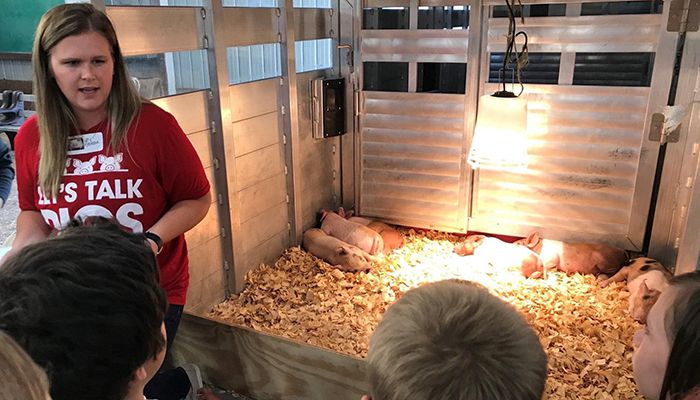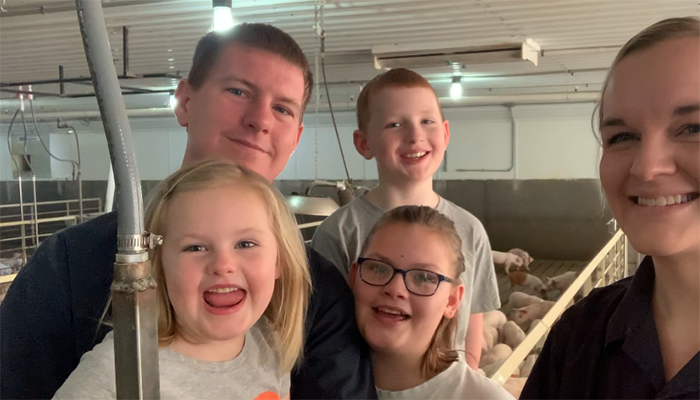What four Iowa farmers want you to know about pig farming
Author
Published
10/13/2021
Information travels fast in today’s world. With so much “knowledge” in the palm of our hands, people sometimes feel like they can be experts on anything!
But here’s the deal: they’re not.
Our search engine questions sometimes lead us to answers that were paid for. Videos and posts can go viral on social media and not contain a shred of truth. And I think we all know, in the quest for clicks and likes, news outlets can get it wrong too.
Agriculture is certainly not immune from “misinformation” that can be innocently spread, and at worst, disinformation meant to purposefully deceive.
Recently, I reached out to four Iowa hog farmers and asked them what they wish consumers knew about pig farming. Here are the real responses from those real farmers—no Googling needed:

Sarah Rickelman of Grundy County is passionate about the well-being of the pigs in her care. She uses the “We Care” principles of pig farming—food safety, animal well-being, public health, environment, people and community— in everything she does. These principles were not developed by a big corporation, she says, but by farmers for the consumer, which includes a farmer’s own family. “I cannot stress enough that although the bottom line is important, and having a successful farm is key, it’s not as important as the animals that we care for and the people for who we provide quality protein.”
Farmers work as a team with food companies, environmental and animal welfare experts and veterinarians to bring the healthiest animals to the United States’ safe food supply.

In Worth County, Nathan and Melissa Moretz say taking care of their pigs is a family affair, with even their youngest children helping with the chores. From the time the pigs arrive on her family farm to the time they go to market, Melissa wants their animals live a comfortable life. “If an animal gets sick, much like taking my own children to a doctor, I have access to a veterinarian to get our animals healthy again,” she says. “I want people to know we feel honored to have the privilege of caring for pigs.”
Even when farmers need to administer antibiotics to animals, it is done with strict oversight to ensure the proper dosage, duration and withdrawal time. This means when an animal goes to market, it does not have any medicine in its system.

Pig health also starts with clean and safe living conditions. Kristin and Sherwin Plate, pig farmers in Mahaska County, want people to understand why they choose to raise their pigs indoors. Their modern hog barn helps keep baby pigs nice and warm during the winter and cool in the summer with misters and fans. “We look in on them every day to make sure they have all the feed and water they could want,” she says.
And today’s pig farms are more sustainable than ever. Over the past 50 years, U.S. pig farmers have used 76% less land, 25% less water and have lowered carbon emissions per pound of pork by 7%.

Randy Francois of Buchanan County says pig barns, like those on his farm, are a humane and environmentally-sound way to raise animals. By being indoors, these barns take predators, disease-carrying animals and weather out of the equation to create a comfortable, healthy home for animals. And instead of being washed away by the rain, manure is collected and put back into the land as a natural fertilizer to help grow next year’s crop which livestock consume—it’s a recycled resource. Not only that, but pigs provide an economic value to Iowa. “Nearly all of Iowa’s hog farms are owned and operated by family farms which provides a stable income source to families and rural communities,” Randy says. “As the world population increases, healthy, safe and affordable protein is a great necessity.”
While Google may have lots of search results on pig farming, when you skip over asking people the “why,” you miss the heart and soul of the true answer: Pig farmers take pride in what they do. That pride drives them to do the right thing as animal caretakers, environmental stewards, responsible neighbors and global providers. That's an "answer" that farmers carry with them every day.
Want more news on this topic? Farm Bureau members may subscribe for a free email news service, featuring the farm and rural topics that interest them most!